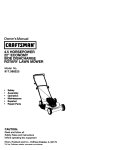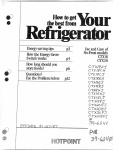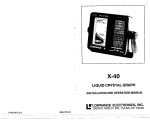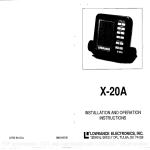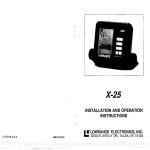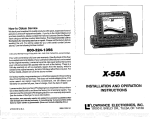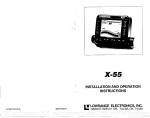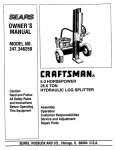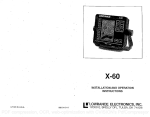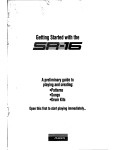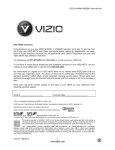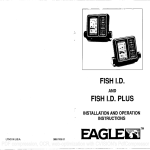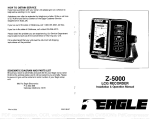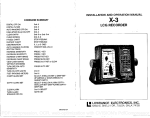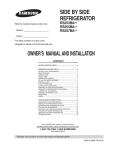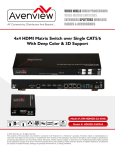Download Lowrance electronic X-20 User's Manual
Transcript
X-20 INSTALLATION AND OPERATION INSTRUCTIONS •LOWRANCE ELECTRONICS, INC. LITHO IN U.S.A. 988-0105-17 12000 E. SKELLY DR., TULSA, OK 74128 PDF compression, OCR, web-optimization with CVISION's PdfCompressor TABLE OF CONTENTS INTRODUCTION INSTALLATION POWER CONNECTIONS NOISE TRANSDUCER KEYBOARDBASICS OPERATION SENSITIVITY CHARTSPEED RANGE ZOOM DIGITAL FISH I.D. FEATURE AUTO ALARMS CHARTALARM FISH ALARM SPEAKER LIGHT MODE TRANSDUCERS AND CONE ANGLES SIGNAL INTERPRETATION FISH ARCHES WATERTEMPERATURE AND TI-IERMOCLINES SURVEYING A LAKE BAIT FISH HOW TO OBTAIN SERVICE SPECIFICATIONS GLOSSARY — 1 1 1 3 3 4 7 7 9 I A AU 4 I Cr 11 12 I — p. ' —— 13 13 iLI 14 23 23 24 24 24 25 ASH ID 1 10 16 18 19 20 s.r jfl JLj a 10 15 15 15 ZOOM ZOOM __J. S .J. L4fl ACTUAL UNRETOUCHED PHOTOGRAPHS TAKEN ON GRAND LAKE OF THE CHEROKEES, OKLAHOMA. a ••_—___.S 4: I I I I fri —: W Fi Copyright© 1989, Lowrance Electronics, Inc. All rights reserved. All featuresand specifications subjectto change withoutnotice. 29 PDF compression, OCR, web-optimization with CVISION's PdfCompressor SENSITIVITY - The ability of a sonar unit's receiverto display targets. Increasing the sensitivity allows weakertargets to be displayed. Also called "gain". SCROLL SPEED - See CHARTSPEED. SHOOT-THROUGH-HULL - A transducer installation which allows the sonar signalsto pass through a fiberglass hull withoutcutting a hole in the hull. SUPPRESSION - A method used in some sonar units to help eliminate interference or noise. SURFACE CLARITY CONTROL- Reduces or eliminatesundesirable signals displayednearthe water's surface. Also called "SCC". THERMOCLINE- A layer of watercaused by the meetingof warm and cool layers of water. The thermocline provides the temperature most fish prefer. TRANSDUCER - The element of a sonar system that converts the electrical energy from the transmitter into ultrasonic sound waves. When a returnecho strikes the transducer, it convertsthesound waves into electrical energywhich is received and displayedby the sonar unit. -A method of mounting transducers sensorson thetransomof the boat. TRANSOM MOUNT or other UPPER/LOWERLIMIT - These are the range limits displayedon the sonar screen or paper. The upper limit is shown at the top of the display, while the lower limit is at the bottom. For example, a 20 to 30 foot range has 20 feet as theupper limit and 30 feet as thelower limit. VIDEO GRAPH - A sonar unit that uses a CAT or television type display. WINDOW - A vertical segment of the depth range. For example, an upper limit of 20 feet and a lower limit of 50 feet creates a 30 foot window. ZOOM - A feature that enlarges targets on the display and shows greater detail. C INTRODUCTION Welcome to the world of sportfishing sonar, Your Lowrance X-20 is a high quality sonar designed for both professional and novice users. These units have an automatic feature that finds and displays the bottom depth, fish, and structure. As you becomefamiliarwith your X20, you can "fine tune" the unitto thesurroundingconditions to getthe most from your sonar. You can programthe X-20 to sound an alarm when a fishor other suspended object enters an alarm zone. You can zoom in and separate fish from structureand othertargets. To get started with your X-20,first read the installation section. This is where it all begins, and improper installation can cause problemsdown the road. After you've readthese instructions and installed your X-20, readtherest of this manual in detail. The moreyou knowwhen you get to the water, the moreyour sonar unitwill do for you. Take this manual for referencewhen you head for thewater. INSTALLATION Mounting Install the X-20 in any convenient location, providedthere is clearance when tilted for thebest viewingangle. Holes in the bracketbase allow wood screw or through bolt mounting. Place a piece of plywood on the back of thin panels to secure the mounting hardware. Make certain there is enough room behind the unit to attach the power and transducercables. You can route the powerand transducer cables through the one inch holein thebase ofthe gimbal bracket. Then passthem througha hole in the mounting surface. First pass thetransducerconnectorand cable up through the hole and gimbal bracket. Then push the power cable wire down through the bracket and dash. After routing the cables,fill the hole with silicone rubber adhesive (RTV). Offset the bracket to coverthe majority of the hole. Power Connections The X-20 operates from a 12 volt battery system. Attach the power cable to an accessory or power buss. If you have problems with PDF compression,28OCR, web-optimization with CVISION's PdfCompressor 1 electrical interference, then attach the cable directly to the battery. Electrical interferenceshows as random dots on the display whenever the boat's engine or an accessory is on. The power cable has two wires, red is the positive lead and black is negative or ground. Attach the in-linefuse holderto the red wire on the powercablewith thecrimpconnector. The other end ofthefuse holder attaches to the battery or accessory buss. If the cable is not long enough, spliceordinary#18 gaugewire onto it. Be certain that the fuse holder is as close to the power source (battery or accessory buss) as possible. This protectsthe powercable and your X-20 in the eventof a short. Use a 3-amp fuse. The X-20 has reversepolarity protection. No damage will occur if the power wires are reversed. (However, the unit will not work until the wires are attachedcorrectly.) OPERATING FREQUENCY and receiver. (See kHz.) - Frequency of a sonar unit's transmitter OUTPUTPOWER - The amplitude of electrical energytransmitted from the sonar unit to the transducer. Measured in wafts, the higher the output power, thedeepera sonar unit can read, and more detail canbe displayed. PIXEL - The small dotsor squareson a liquidcrystal display or CRT. PIXEL DENSITY - The number of pixels per square inch on a liquid crystal display. Typically, betterthe resolution. the greater number of vertical pixels, the PULSE LENGTH - The amount of timethat thesonar transmits. This is measured in micro-seconds. The shorter the pulse length, the better the resolution. For example, a 30 micro-second pulse length is equal to a one inch resolution. RANGE - The section of water shown on the sonar display. For example, a 60 foot range has zero for the upper limit and 60 for the lower limit. REMOTE - An intelligent "repeater" unitthat receives depth information from another sonar unit. A remote doesn't have a transmitter or receiver. However, it does have it's own features that are adiustable and operate separatelyfrom the master. RESOLUTION FUSE - The ability of a sonar unit to separate targets from each other or from the bottom. SCALE - The markings on a sonar units display. To determine the depth of a target, simply compare the target's location to the location of the scale markers on thedisplay. 12 VOLT BATFERY SECOND ECHO - Another echo that registers at roughly twice the depth of a target echo. This is caused by the soundwavesreflecting off the bottom, strikingthe surface of the water, travelling to the bottom again, and returning to the surface. SECOND FUNCTION KEY- A buttonthat converts the functions of the primarykeys to otherfunctions. 27 PDF compression,2 OCR, web-optimization with CVISION's PdfCompressor The Discrimination feature on Lowrance sonar units removes many false signals from other sonars, acoustic and electrical sources, and more. FISHALARM - An alarm that activates whena fish or suspendedobject is detected. FISH ARCH - A sonar with good resolution and definition can display suspended targets as upside down "Vees" or arches. These signals are typically fish, hence the name "Fish Arch". See page 20 for more information. FLUSH MOUNT - A transducer that is installed with the bottom of the transducer flush with the bottom of the hull. GIMBAL BRACKET - A bracket used to install a sonar unit permanently. The sonar unit can rotate in the bracket for the best viewing angle. Thi GRAYLINE feature shows the relative strength of signals displayedon thescreen. Signals weakerthan the GRAYLINE setting are displayed in black, strongertargetsare gray. It also gives clues to the composftion of the bottom. In other words, you can tell if the bottom is softor hard. A hard bottom returns a strong signal causing a wide gray line. A soft, muddyor weedy bottom returns a weaker signal which is emphasized with a narrowgray line. IN-DASH - A sonar unit installed through a hole in the boat's dash. Usually, the face of the sonar is flush or nearly so with the dash. NOISE Minimize electrical noise by routing the power cable away from other possible sources of electrical interference. One of the largest noise generators is the engine's wiring harnessthat runs from the engine to the instrument panel. This harness usually contains a wire for the For best tachometer which radiates RF (radio frequency) energy. cables from the away engine results, keep the power and transducer wiring. Also, bilge pump wiring can sometimes radiate noise so try to keep the X-20's cables away fromthose wires. VHF radio antenna cables typically radiate RF energy at higher power levels than the engine's wiring harness. It is important to keep the X20's power and transducercables as far away as possible from VHF radio cables. If interference begins at slow boat speeds, worsening astheboat speed increases, then a probablecause is acoustic noise, or cavitation. This noise is not electrical, but rather mechanically induced noise from the transducer. Stop the boat, put the engine in neutral, and increase the Rpm. If the noise does not increase on thedisplay,then it is cavitation. Usually, air bubbles passing over the face of the transducer create acoustic noise. The faster a boat travels, the more air bubbles increase and generate noiseon thedisplay. To eliminatethis problem, read the transducer installation sectionfor proper mounting techniques. TRANSDUCER kHz - Kilohertz. A measurement of frequency. Your Lowrance sonar Transducer installation instructions are packaged separately with the transducer. Please readthe instructions carefullybeforeyou install the operates at 192 Kilohertz. (192,000 cycles per second). transducer. LCD - Liquid crystal display. The screen or display of a Liquid Crystal Graph sonar instrument. Periodically wash the transducer's face with soap and waterto remove any oil film that may collect. Oil and dirt on the face will reduce the sensitivity or may even prevent operation. LCG - Liquid Crystal Graph. NOISE - Any undesired signal. Electrical noise is caused by engine ignitions systems, radios, etc. Acoustic noise is causedby the vibration of the engine or other mechanical sources. Noise appears on the display as random dots or lines. Paint transducers on salt water boats with a thin coat of anti-foulant paintto prevent organisms from growing. If unchecked, barnacles and other marine growth will cause a decrease in the transducer's sensitivity. Do not use a metal based anti-foulant paint as it will decrease the transducer's sensitivity. There are special anti-foulant paints specificallydesigned fortransducers. They'rereadilyavailable at mostmarine dealers 3 PdfCompressor PDF compression,26 OCR, web-optimization with CVISION's Operating Current 200 ma (lights off) 500 ma (lights on) Operating Voltage 9-15 vdc Number of pixels 50 x 27 Display Scroll Speed .5" per minute (minimum) 32" per minute (maximum) Maximum Chart Range Maximum Digital flange (vertical x horizontal) 1350 Total 180 feet 400 feet GLOSSARY ANCHOR WATCH - A selling of the sonar unit's alarm. The alarm activates when the boat drifts into shalloweror deeper waterthan the alarm set points. BACK-LIGHTED- A displayor keyboard illuminated from behind by a light. Back-lighted displays are essential when nightfishing or navigatKEYBOARDBASICS ing. This section gives a brief explanation of the keyboard. Read the Operationsectionfor a detailed description of each key's operation. CAVITATION- Air bubbles created by the high speed movement of a boat or transducer through water. ON OFF L J These keys turn the unit's power on and off. To turn it on, simplypresstheON key. To turn it off, press the OFF key. [J Pressing any key generates a tone or "beep." Thistells you ________ that the unit has accepted a command. CHART SPEED - (1) The speed of the chart paper on a paper graph recorder. (2) The speed of an image across the screen of a liquid crystal graph. (Alsocalled "scroll speed"). CONE ANGLE - Angle of the transducer'scone of sound. Lowrance hastransducers available with cone angles from 8 to 45 degrees to suit thevarying needs of fishermen. CRT - Abbreviation for Cathode flay Tube. See Video Graph. DEFINITION UP and DOWN ARROWS These keys are used to adjust virtually every feature and _________ function on the unit. Use thesekeys to adjustthe sensitivity, chart speed, range, zoom and chart alarm. - The ability of a sonar unit's display to show detail. A display with high definition can show more detail than one with low definition. DISCRIMINATION - A feature available on Lowrance L.C.G.'s and paper graphs that separates false echoes from truetarget information. 25 PDF compression,4 OCR, web-optimization with CVISION's PdfCompressor BAIT FISH The importance of bait fish to successful fishing can't be over-emphasized. They are the principalfood of all game fish in mostwaters. Bait fish are the plankton feeding forage fish, such as minnows and shad. Bait fish can also be the young of game fish, such as crappies, bluegill, and bass. Most bait fish concentrate within five feet of the surfacewhere sunlight promotes the growth of the plankton on whichthey feed. One method of fishing is to use the unit to find the bait fish first. A school of baitfish will look like a cloud" on the units display. Usually, game fish will be nearby, often directly beneath the school of bait fish. HOWTO OBTAIN SERVICE If you have a problemwith your sonar unit, pleasegive us a chance to help beforesending it in for repair. Call or write the Factory Customer ServiceDepartment at 1-800-331-3889, extension 401, toIl free. Oklahoma residents call 918-437-6881, extension 401, collect. Please detail the problem you are experiencing. The service department maybe able to save you the inconvenience of returning your unit. Ifthe unit mustbe returned, pack it carefullyso it won't be damaged. It r 1 _______ is advisable to insure theunit in case it's lost or damaged duringtransit. Mail To: Lowrance Customer Service 12000 E. Skelly Drive Tulsa, OK 74128 r t - _____ SPECIFICATIONS Dimensions Weight 5718"Hx7314"Wx37/16"D Transmitterfrequency Output Power (typical) 192 kHz 275 watts peak to peak 34.4 watts RMS Receiver Sensitivity 82 db temperature stabilized 1 _______ SENS. This key and the arrow keys adjustthe graph'ssensitivity. (The digital's sensitivity is adjusted by the unit automatically.) The receiverhas 32 steps of adjustment. CHARTSPEED Vary the speed of the chart with this key and the arrow keys. Thereare 5 steps of chart speed adjustment. RANGE The depth range is changedwith this key and the arrow keys. The rangesvary from 0-5 feet to 0-180feet. 3/4 pounds CHARTALARM Using this key activates the chart alarm. A bar appears on the left side of the display when the chart alarm is adjusted. Anytargetthat appears on the screen between the top and bottom of thechart alarm bar triggers thealarm. 5 PDF compression,24OCR, web-optimization with CVISION's PdfCompressor stay. Schooling fish suspended over deep water lie at the level that providesthis temperature. We assumethey are the most comfortable here. The temperature of water in the lake is seldom constant from top to bottom. Layers of different temperatures form, and the junction of a warm and cool layer of water is called a thermocline. The depth and thickness of the thermocline canvary with the seasonor timeof day. In deep lakes there maybe two or more at differentdepths. Thermoclines are important to fishermen because they are areas where fish are active. Many timesbait fish will be above the thermocline while larger game fish will suspend in or just below it. The X-20 can detect this invisible layerin the water, but the sensitivity will probablyhaveto be turned up to see it. 1 _______ fl • r I L. j 1 MODE The X-20 has five different screens" or modes of operation. Use this key to switch between modes. FISH I.D. This key turns the Fish l.D. feature off and on. 1 • 1101 IL. FISHALARM Press both the Fish ID. and the AUTO key at thesametimeto activate the FishAlarm. This is an audible fish alarm. AUTO Turningtheuniton enables theautomatic mode. To switch to the manual mode, presstheAUTO key. You can return theunit to automatic at anytime by pressing theAUTO key again. SURVEYING A LAKE The most successful anglers on any bodyof waterare thosewho fish it day afterday and year afteryear. Eventually, they learn thehot spots that produce fish consistently. They discover through experience where, and at what depth, they can expect to find the fish they want at any season. And they realize that these productive areas change throughout the year depending on water level, temperature, food, and other factors. WiththeX-20, anyone can eliminate guesswork and concentrate on the areas where fish are likely to be. Even if it's thefirst time on the lake! The most efficientway to become acquainted with a bodyof wateris to survey it with your unit. Start with a map of the lake, if possible, and indicatethe promising spots in relation to landmarkson shore. As you go about your survey, your unit will tell you thedepth and typeof bottom. It will also reveal suspended fish. Keep a few marker buoys in the boat, ready to toss overboard. When the unit indicates a school of fish, throwthe buoy out. Withthe school thus marked, you can make your turn and come back to fish in exactly the right spot. This is essential when you're far from shore on a big lake. Unless you mark the school of fish when you're over it, you may not be able to find it again. 23 PDF compression,6 OCR, web-optimization with CVISION's PdfCompressor WATERTEMPERATURE AND THERMOCLINES Water temperature has an important-if not controlling-influence upon the activities of all fish. Fish are cold blooded and their bodies are always the temperature of the surrounding water. During the winter, colder water slows down their metabolism. At this time, they need about a fourth as muchfood as they consume in the summer. Most fish don't spawn unless the water temperature is within rather narrow limits. A surface temperature meter such as Lowrance's LDT3000 helps identifythe desired surface water spawning temperatures for various species. Trout can't survive in streamsthat get too warm. Bass and otherfish eventually die outwhen stocked in takes that remain too cold duringthesummer. While some fish have awider temperature tolerancethan others, each has a certain range within which it tries to OPERATION SENSITIVITY When first turned on, the X-20 is in the AUTO SEARCH mode. The micro-computer automatically adjusts the sensitivity and range to find and lock onto the bottom. Thedigital depth flashes"0" until it finds and locks onto the bottom. You can leave the sensitivity in the automatic mode or manually adjust it to suit conditions. You mayneed to increase thesensitivity to show fish symbols whenthe unit is in automatic. To do this, first press the SENS. key. The letters "SENS"will flashon the right side of the display. A verticalbarappears on the left side of thescreen. ( See below.) This indicates the sensitivity level. To increase the sensitivity, press and holdthe up arrow key until the sensitivity is at the desired level. The down arrow key decreases sensitivity in the same manner. Notice how the sensitivity bar moves as you change settings. It will move up when the sensitivity is increased. You'll also see the change on the display. After you've finished setting the sensitivity level, the letters 'SENS" and the sensitivity bar will disappearafter eight seconds. Whenthe Fish l.D. feature is off, the sensitivity can be increased more, even if the unit's automatic featureis on. Thiswill help displayfish and other small detail. Whenautomatic isturned off, the sensitivity level can be increased to its maximum level. PDF compression,22OCR, web-optimization with CVISION's7 PdfCompressor With highsensitivity settings, a second bottomecho (second echo) may appear. This is normal. It's caused by the returning signal reflecting off the surface of thewater. Then it makes a second trip to thebottomand back again. <— . A Remember, when the unit's automatic feature is on, the receiver's sensitivity automatically adjusts to the surroundingconditions. The microcomputerplaces it at a level slightlyabovethe minimum required to pick up the bottom signal. However, it's possible to change the sensitivity level while the unit is in automatic. This maybedesirableif the sensitivity level is not high enough to show fish or other small detail. The unit will increase the sensitivity to pick up thebottom signal, then add in the level you programmed. To adjust the sensitivity while the unit is in automatic, simplypress the SENS. key. Then press either the up arrow key to increase it, or the down arrow key to decrease it. As you press the arrow key, the sensitivity bar moves up or down, according to the sensitivity level chosen. You can adjustthe sensitivity in the samemannerwhentheunitis in the manual mode. BOAT'S DIRECTION OF TRAVEL • .• .U• U B :z• U U U C Very small fish probablywill not arch at all. Medium sizedfish will show a partial arch, or a shape similar to an arch if they're in deep water Largefish will arch, but turn the sensitivity up in deeperwaterto seethe arch. Because of water conditions, such as heavy surface clutter, thermoclines, etc., the sensitivity sometimes cannot be increased enoughto get fish arches. One of the best ways to get fish arches is to expand or "zoom" a segmentof thewater. For example, from45 to 60 feet. The smallerthe segment,the betterthe screen resolution will be. For the best results, turnthesensitivityup as high as possible withoutgettingtoo much noise on the screen. In medium to deep water, this method should work to displayfish arches. 21 PDF compression,8 OCR, web-optimization with CVISION's PdfCompressor r ci 3.; 11 i ZOOM flSH D 57L_J CHART SPEED At power on, thechart speed scrolls at a preset speed. To change the speed, pressthe CHARTSPEED key. The word "CHART" will flash on the right side of the display. A vertical bar will also appear on the left side of the screen. This indicates the currentchart speed. Next, press the up arrow key if you wish to increase the chart speed. Press the down arrow key to decrease it. When the chart reachesthe desired speed, release the key. There are five stepsof chart speed. When the chart speed reachesits maximum or minimum level, the unitwill sound atone. El Big rocks or stumps on a smooth bottom send back signals above the bottom level signal. The height of the signal dependson the target's height. As you pass over a post, it should be clearly visible as a short line extending above thebottom signal. A steep slope returns a wide signal, the steeperthe wider. Signals returned from a high underwater cliff are usuallythe widest of all. Brush usually lies on the bottom and shows up as clumpsrising above the bottom signal. Brush signals look similarto large rocks; however their signal is not as strong as rock. FISH ARCHES Fish arches are created when the cone of sound passesover a fish. The distance to a fish when the conefirst strikes it is shown as "A" on the next page. When the center of the cone strikes the fish, the distance is shorter, as shown in "B". As the cone leaves the fish, the distanceincreases again as shown in "C". To viewthe chart speed withoutchanging it, press the CHARTSPEED key. The chart speed bar will appear for eight seconds. When the Fish l.D. feature is off, the depth of the water will affect the size and shape of the fish arch due to the cone angle diameter. For example, if the cone passes over a fish in shallow water, the signal displayedon theunit maynot arch at all. This is due tothe narrowcone diameterand the resolution limitations of the display. and CHARTSPEED keys again to start the display moving at the last chart speed setting. If the digital sonar is on, the bottomdepth will still be displayed. The digitaldoes not stopwhenthechart is in the"freeze" At times it is desirable to stop or "freeze" the display to examine an echo before it scrolls off the screen. Pressing the SENS. and CHART SPEED keys at the sametime will freezethe display. Press the SENS. mode. 9 PdfCompressor PDF compression,20OCR, web-optimization with CVISION's RANGE The range automatically changes to keep the bottom signal on the display when the unit is in automatic. The range cannot be manually changed when the unit is in the automatic mode. The range can be changedin manual mode. Thereare six ranges available:0-5, 15, 30, 60, 120, and 180 feet. To change the range, first makecertain the word AUTO is off. Then press the RANGEkey. The word RANGE will flash on the right side ofthescreen. Next, presstheup arrow keyto switchto a shallowerrangeor press thedown arrow key for a deeperrange. The rangeannunciator will stopflashing eightseconds afterthe last key was Both 8 degree and 20 degree transducers give accuratebottom readings, even though the bottom signal is much wider on the 20 degree model. This is because you are seeing more of the bottom. Remember, the shallowedge of thesignal showsyou thetrue depth. The rest of the signal tells you whetheryou are over rocks, mud, etc. pressed. 50' 100' 150' 200' 20°at ZOOM - Automaticoperation Press the ZOOM key to double the size of thetargets on the display. It works by enlargingthe bottom half of the selected range. For example, if the range is 0 - 60 feet and thezoom key is pressed, the new range will be 30 - 60 feet. If the unit is in automatic, thebottom will be tracked in this 30 foot window. There are two exceptions to this rule: 1) If you're on the 0-15' range and pressthe zoom key, the new range will be 1015'. 2) There is no zoom on the 0-5' range. 8°at3db SIGNAL INTERPRETATION Your unitgives an accuratepicture of the bottom that your boat is passing. A bottom of firm sand, gravel, shell, or hard clay returns a wide bottom signal. If theautomatic feature is off and the bottomsignal narrows , then it means that you have moved over a mud bottom. Mud absorbs the sound wave and returns a weak signal. Turn up the sensitivity to see a betterbottom signal. 19 PDF compression,10 OCR, web-optimization with CVISION's PdfCompressor MODE 5-All chart, High Speed Scroll. In this mode the chart scrolls at highspeed. The chart speed can be adjusted with the CHART SPEED key if desired. a) Chart uses full screen. b) No digital depth indicator. _ta sa •a iii •a Cu c) No FASTFRAK. No automatic operation allowed. d) e) No h-in -IL, ZOOM - Manual Mode Zoom operates differently when the unit is in the manual mode. The range doesn't change when the zoom key is pressed. Instead, press the down arrow keyto shift therangedown in one footincrements. The up arrow key shiftsthe rangeup in one foot increments. For example, if the unit is on the 0-60toot range, and the manual mode is on, pressing the zoom key, then thedown arrow key once will move the 0-60' range to 1'-61'. The best way to use this feature is to changethe range to a smaller one, then press the zoom key, shift the range until the area is displayed that youwant zoomed. For example, if the bottomdepth is 50 feet, and youwish to enlargethe areaimmediately aboveit, first change the range to 0-15 feet. Now press the zoom key. Finally, press the down arrow key until the bottom appears. Now you have a fifteen toot zoom window around the bottom signal. in iLl -. Fish l.D. feature or Fish Alarm AUTO f) Chart alarm is allowed. F1 D En I TRANSDUCERS AND CONE ANGLES The sound waves from the transducer spread out into the water in a cone shaped beam. This looks much like the beam from a flashlight. The angle between the outside edges of the cone is the cone angle. Lowrance offers a choice of transducers with either an 8 or 20 degree cone angle. Typically, wide cone angle transducers (20 degrees) are idealfor operating in shallow to medium water depths. The 20 degree cone angleallows you to see more of the underwater world. In 15 feet of waterthe 20 degreecone covers an areaabout six feet across. The 8 degree transducer covers only about a two foot circle. The 20 degree transducer is almost always the best to use in fresh water, the 8 degree mostly in salt water. In a deep water environment, (300 feet - fresh water, 100 feet - salt water) the narrow cone angle is more desirable. Since the sound energy is concentrated in a smaller area, ft can penetrateto much deeperdepths. rn DLI DIGITAL Built inside the X-20 is a complete digital sonar. It works automatically to discriminate between the valid bottom echoes and false echoes from fish, thermoclines, or other signals. The digital display will show only the bottom depth. At power on, the digital will flash "0" until it has "locked on" to the bottom signal. Once it has acquired the bottom depth, it will display ft in the lower left side of the display. 11 PDF compression,18 OCR, web-optimization with CVISION's PdfCompressor FISH I.D. The Fish 1.0. featureis automatically on whentheunit is firstturnedon. The computer insidethe unit analyzes all echoes, filtering out unwanted signals. It helps eliminatesurface clutter, thermoclines, and other undesirable signals. The remaining suspended targets are usually fish. Targets that are identified by the unit as fish are displayed as small, medium, or large fish symbols on the display. These symbols are shown according to the relative size ofthe fish as seenby the unit. The Fish l.D. feature canonly be used in automatic. If you wishto turn it off, or back on again, press theFISH l.D. key. If youpresstheFISH l.D. key when theunit is in manual, it will put it in automatic and enable the Fish l.D. feature. MODE a) 3 - Big digital. The digital depth numbers use the lower quarter of the display. b) No FASTRAK challenge ••aNanu__a..n. the Fish 1.0. feature. Also, large amounts of noise can fool the Fish l.D. feature. This is usually caused by a poor transducer installation. Although the Fish l.D. feature isn't perfect, it 31$ - — fl a. C urn I 4• uu — I I AUTO C •C. is individual tree branches extending out from groups of branches. These canbe mis-identified as fish by • RANGE -. Ifyou havedifficultyshowing fish symbols, try increasing the sensitivity. U AUTO1 played in whole numbers. To show fish symbols, you must be traveling at a slow trolling speed. There shouldbe somemovement ofthe boat for the Fish l.D. featureto work properly. NOTE: The Fish l.D. feature cannot distinguish between fish and other suspendedobjects such as turtles,tree branches, trotlines, submerged floats, or other inanimate objects. The micro-computer in this unit is sophisticated, but it can be fooled. The most difficult - • The depth is displayed in tenths of a foot to 99.9 feet, then it is dis- • 15 ZOOM iii FISH ID gui C MODE 4- - Depth only displayed in large digits. No chart is displayed. I 26 can be a valuableaid to thefisherman. 17 PDF compression,12 OCR, web-optimization with CVISION's PdfCompressor MODE TheX-20 has five differentscreen modes. To change modes, pressthe MODE key. Keep pressing the MODE key until the desired screen appears. A summary of the differentscreen modes follows. MODE 1 - Thisis the default mode usedwhen the unitis firstturned on. It hasthefollowing features: a) •13I Small digital depth dis- play in lower left corner. It does not show tenths of a foot. Normal chart display. AUTO AUTO When the unit is first turned on, the automatic feature is enabled. It works automatically to find and displaythe bottomdepth. The sensitivity and range are also adjusted to keep the bottomsignal on the screen at all times. To turn the automatic feature off, simply pressthe AUTO key once. The word "AUTO" will disappearfrom thedisplay, signifying the automatic sensitivity and chart range features are off. This also turns the Fish l.D. featureoff at the sametime. The digital remains on. To return the unit to the automatic mode, press the AUTO key again. This will reset thesensitivity, so you maywish to increase it to see fish or other detail. This will notturn theFish l.D. feature on. You will have to pressthe Fish l.D. key to turn it on. RANc b) No FASTRAK. 213 4. I I R1D t tin -'U ___.— V AUTO IL! r] ZOOM I FisI-l to —---i 2: MODE 2 - This is the same as mode 1 except it has FASTRAK. This displays on the right side of the screen. It converts all echoes to horizontal bars when they AUTO J .rjr RA?4&E "p Cu first appear on the This gives a screen. rapid update of p 'in condi- tions directly under the boat. Echoes are also — scrolled normally across the display. The Fish l.D. feature is not available with this mode. —H-I ALARMS The unit has two different alarms, a chart alarm and Fish Alarm. The chart alarm consistsof a barthat displayson the left side ofthe screen. The alarm "chirps" whenever the unit detects an echo inside the boundaries of the bar. or other suspended with the Fish ID. feature. objectsare detected. It works in conjunction sounds different than the To separate the alarms, the fish alarm's tone same time. chart alarm. Both alarms may be used at the Fish Alarm sounds an audible alarm when fish 6" PDF compression, OCR, web-optimization with CVISION's PdfCompressor 16 13 CHARTALARM To setthe ChartAlarm, press theCHARTALARM key on the keyboard. Thewords "Chart Alarm" flashesin the lowerright cornerofthescreen. A verticalbar also displayson the left side ofthe screen. It will stay on thescreen for eightsecondsor foreightsecondsafteryou have finished adjusting it. This is the ChartAlarm's "window" Anyechothat appears between the top and bottom of this bar will sound the alarm. Adjust deep end of this barto make a smalleror larger alarm "window." The shallow end is automatically adjusted by the unit so it won't be triggered by surface clutter or other false signals. Next, pressthedown arrow to move the bottom of the bar deeper, or press the up arrow to move it shallower. Eightsecondsafterthe last button is pressed, thealarm bar will disappear. To turn theChart Alarmoff, pressthe CHARTALARM key, then move the bottom of the bar all the way to its shallowest position using the up arrow key. FISH ALARM Use the FISH ALARM for a distinctiveaudiblealarm when fish or other susupended objects are detected by the FISH 1.0. feature. Press the FISH l.D. and the AUTO keys at the same time. The words "FISH ALARM" displays at the bottom right side of the screen. The audible alarm sounds each time the Fish 1.0. feature detects a fish or other suspended object. There is a different tone for each fish symbol size. To turn the Fish Alarm off, press the FISH 1.0. and AUTO keys at the n same time. Li SPEAKER g 1 RANGE 20 / The speakercan be turned on and off by pressing the up and down arrow keys at the same time. The speaker is represented by a note symbol abovethe arrow keys. Wheneverit is enabled, a note symbol appears on the right centerside of the display. The speakeris enabled whentheunit is turnedon. NOTE: This applies to the alarms only. The unit will still sound a tone when a key is pressed and the speaker is turnedoff. LIGHT A light allowsoperation of the unit at night. Turning theunit on causes the lights to flash for six seconds. Pressthe RANGE and ZOOM keys at the same timeand the lights will stay on. To turnthe lights off, press the RANGE and ZOOM keys again. The lights will also go out when the unit is turned off. When the "Chart Alarm" signal is on, the alarm is active. If you wish to view the Chart Alarm bar, simply press the CHART ALARMkey. The barwill be displayedfor eight seconds. Any targetthat appears on the left side of the screen in the area covered by the chart alarm bar will trigger the alarm. a Jr .--- If the range is changed, theChart Alarm may need to be changed also since it does not track range settings. 14 15 PDF compression, OCR, web-optimization with CVISION's PdfCompressor
















